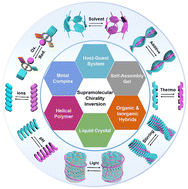Self-assembled stereomutation with supramolecular chirality inversion
Abstract
Supramolecular chirality is involved not only in biological events such as gene communication, replication, and enzyme catalysis but also in artificial self-assembly systems and aggregated materials. The precise control of supramolecular chirality, and especially supramolecular chirality inversion (SMCI), would deepen the understanding of chiral transfer and regulation in both living systems and artificial self-assembly systems, providing efficient ways to construct advanced chiral materials with an optimum assembly pathway necessary for various functions. In this review, the fundamental principles of SMCI are comprehensively summarized, with a focus on the helical assemblies having opposite handedness or chiroptical properties of the compositions. Thereafter, various SMCI strategies that have been developed for chiral nanostructures and assembled materials are systematically reviewed, and the promising applications of SMCI, including chiroptical switches, chiral recognition, enantiomeric separation, asymmetric catalysis, chiral optoelectronic materials, chiral spin filters, and biomedical uses, are highlighted accordingly. Finally, the scientific challenges and future perspectives for assembling materials with SMCI are also discussed.



 Please wait while we load your content...
Please wait while we load your content...